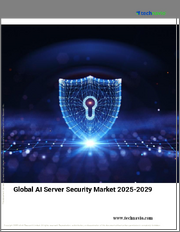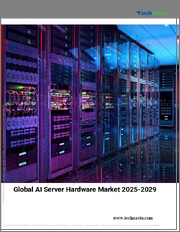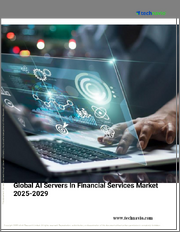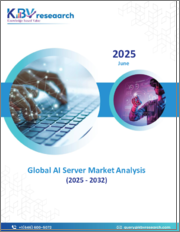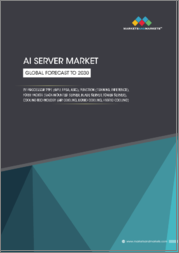
|
시장보고서
상품코드
1718461
AI 서버 시장 : 프로세서, 최종사용자, 애플리케이션, 배포 모드별 - 세계 예측(2025-2030년)AI Server Market by Processor, End-User, Application, Deployment Mode - Global Forecast 2025-2030 |
||||||
AI 서버 시장은 2024년에는 504억 8,000만 달러에 달하며, 2025년에는 597억 8,000만 달러, CAGR 19.58%로 성장하며, 2030년에는 1,476억 5,000만 달러에 달할 것으로 예측됩니다.
| 주요 시장 통계 | |
|---|---|
| 기준연도 2024 | 504억 8,000만 달러 |
| 추정연도 2025 | 597억 8,000만 달러 |
| 예측연도 2030 | 1,476억 5,000만 달러 |
| CAGR(%) | 19.58% |
인공지능 기술의 발전은 컴퓨팅의 새로운 시대를 열었고, AI 서버는 디지털 혁신의 중추가 되고 있습니다. 역동적인 발전과 끊임없는 효율성 추구가 특징인 이 산업에서 AI 서버 시장은 혁신의 최전선에 서 있습니다. 전 세계 조직들은 데이터 중심의 의사결정을 촉진하고 복잡한 머신러닝 작업을 지원하기 위해 이러한 강력한 서버를 활용하고 있습니다. 이 보고서는 현재 상황을 종합적으로 분석하고 주요 동향, 시장 역학 변화, 경쟁 환경을 재정의하는 전략적 인사이트을 언급하고 있습니다.
최근 AI 서버의 성능과 확장성을 강화하는 첨단 하드웨어 아키텍처와 최적화된 소프트웨어 프레임워크의 통합이 빠르게 진행되고 있습니다. 의사결정자들은 이제 분산 아키텍처와 클라우드 기반 솔루션이 전통적인 컴퓨팅 모델을 어떻게 재구성하고 있는지 이해하는 데 그 어느 때보다 집중하고 있습니다. 세계 기업이 디지털 전환의 여정을 이어가는 가운데, 오늘날의 처리 요구사항을 충족시킬 뿐만 아니라 AI가 주도하는 내일의 세계 수요를 예측할 수 있는 솔루션을 찾고 있습니다.
이 소개에서는 획기적인 기술 도입과 전략적 투자의 상호 작용이 새로운 기회와 도전을 동시에 창출하고 있는 AI 서버 시장을 자세히 살펴볼 수 있는 무대를 마련했습니다. 이 보고서의 다음 섹션에서는 AI 서버 분야를 형성하는 여러 세력에 대해 자세히 살펴보고, 시장 세분화, 지역 분석, 기업 인사이트, 실행 가능한 권장 사항을 결합하여 업계 리더와 이해관계자에게 보다 풍부한 관점을 제공합니다.
AI 서버 시장의 변화
AI 서버 시장은 업계의 판도를 바꾸는 변혁의 시기를 맞이하고 있습니다. 프로세서 아키텍처의 최첨단 발전은 AI 알고리즘의 끊임없는 진화와 함께 컴퓨팅 파워의 재정의로 이어지고 있습니다. 더 많은 기업이 하이브리드 및 분산형 인프라로 전환함에 따라 전통적인 중앙집중식 데이터센터 패러다임이 재평가되고 있습니다. 이러한 전환은 적응형 리소스 관리와 네트워크 민첩성에 대한 관심이 높아지면서 운영 비용을 절감하고 성능을 최적화할 수 있게된 것이 영향을 미치고 있습니다.
이러한 진화에 기여하는 주요 요인으로는 클라우드 기반 인프라의 통합과 엣지 컴퓨팅의 가속화를 들 수 있습니다. 이러한 요인들로 인해 실시간 처리가 필요한 용도에 필수적인 요구사항인 지연을 최소화한 빠른 서비스 제공이 가능해졌습니다. 또한 AI를 활용한 분석의 인기가 높아지면서 서버가 데이터 처리뿐만 아니라 거의 실시간으로 학습과 적응을 담당하는 혁신적인 컴퓨팅 모델을 채택하고 있습니다.
또한 친환경 솔루션에 대한 세계 수요에 부응하기 위해 업계는 재생에너지와 지속가능한 기술에 대한 투자를 늘리고 있습니다. 레거시 컴퓨팅 시스템에서 더 높은 처리량과 에너지 효율을 제공하는 보다 강력한 플랫폼으로 전환하는 것은 보다 탄력적이고 반응성이 높은 시장으로 가는 길을 열어주고 있습니다. 기존 모델이 AI와 머신러닝이 지배하는 미래로 나아가는 가운데, 기업은 변화가 선택이 아닌 생존과 경쟁력에 필수적이라는 매우 중요한 기로에 서 있습니다.
AI 서버 시장의 주요 세분화 인사이트
시장 세분화를 자세히 살펴보면, AI 서버 영역을 다각적으로 이해하는 데 도움이 되는 복잡한 계층이 나타납니다. 프로세서 기반 분석에서는 시장이 특정 용도용 집적회로(Application-Specific Integrated Circuit), 필드 프로그래머블 게이트 어레이(Field Programmable Gate Arrays), 그래픽 처리 장비(Graphics Processing Units)로 나뉩니다. 그래픽 처리 장비(Graphics Processing Units)에 걸쳐 조사되는 다양한 기술 생태계를 강조합니다. 이들 프로세서는 각기 다른 방식으로 혁신을 주도하며, 특정 컴퓨팅 수요를 충족시키는 고유한 기능을 제공합니다.
최종사용자별 세분화는 클라우드 서비스 프로바이더, 기업, 정부 기관의 다양한 요구를 고려한 시장 분석을 통해 이러한 이해를 더욱 심화시킵니다. 각 고객 부문은 확장성과 유연성이 뛰어난 아키텍처의 필요성부터 증가하는 사이버 위협에 대비한 보안 프로토콜 강화에 이르기까지 고유한 과제와 요구사항이 존재합니다. 이러한 최종사용자들은 AI 서버의 배포와 발전의 기반이 되는 중요한 축이며, 커스터마이징과 운영 효율성을 중요하게 여깁니다.
용도별 시장 세분화 연구는 컴퓨터 비전, 생성형 AI, 머신러닝, 자연 언어 처리 등의 기술 기반에 대해 살펴봅니다. 이 분야에서는 방대한 양의 데이터를 실시간으로 처리해야 할 필요성이 혁신을 주도하고 있으며, 자율 시스템, 예측 분석, 대화형 AI의 획기적인 발전을 가능하게 하고 있습니다. 이러한 용도의 급속한 확산은 전문 AI 솔루션이 다양한 산업에 큰 영향을 미치며 성장과 기술적 수렴을 촉진하고 있음을 보여줍니다.
마지막으로 클라우드 기반 또는 온프레미스 구축에 따른 구분은 AI 서버 솔루션의 유연성과 적응성을 통해 다양한 운영 환경의 선호도를 충족시킬 수 있다는 점을 강조하고 있습니다. 클라우드 기반 구축이 확장성과 유지보수 오버헤드 감소를 약속하는 반면, 온프레미스 시스템은 강화된 데이터 보안과 낮은 레이턴시를 필요로 하는 조직에 여전히 필수적입니다. 이러한 세분화에 대한 인사이트는 현재 시장 상황을 반영할 뿐만 아니라 미래의 혁신과 확장을 위한 로드맵을 제공하는 다차원적인 프레임워크를 형성하고 있습니다.
목차
제1장 서문
제2장 조사 방법
제3장 개요
제4장 시장 개요
제5장 시장 인사이트
- 시장 역학
- 성장 촉진요인
- 성장 억제요인
- 기회
- 해결해야 할 과제
- 시장 세분화 분석
- Porter’s Five Forces 분석
- PESTLE 분석
- 정치
- 경제
- 사회
- 기술
- 법률
- 환경
제6장 AI 서버 시장 : 프로세서별
- 특정 용도용 집적회로(ASIC)
- 필드 프로그래머블 게이트 어레이(FPGA)
- 그래픽스 프로세싱 유닛(GPU)
제7장 AI 서버 시장 : 최종사용자별
- 클라우드 서비스 프로바이더
- 기업
- 정부기관
제8장 AI 서버 시장 : 용도별
- 컴퓨터 비전
- 생성형 AI(GenAI)
- 기계학습
- 자연언어처리
제9장 AI 서버 시장 : 배포 모드별
- 클라우드 기반
- 온프레미스
제10장 아메리카의 AI 서버 시장
- 아르헨티나
- 브라질
- 캐나다
- 멕시코
- 미국
제11장 아시아태평양의 AI 서버 시장
- 호주
- 중국
- 인도
- 인도네시아
- 일본
- 말레이시아
- 필리핀
- 싱가포르
- 한국
- 대만
- 태국
- 베트남
제12장 유럽, 중동 및 아프리카의 AI 서버 시장
- 덴마크
- 이집트
- 핀란드
- 프랑스
- 독일
- 이스라엘
- 이탈리아
- 네덜란드
- 나이지리아
- 노르웨이
- 폴란드
- 카타르
- 러시아
- 사우디아라비아
- 남아프리카공화국
- 스페인
- 스웨덴
- 스위스
- 튀르키예
- 아랍에미리트
- 영국
제13장 경쟁 구도
- 시장 점유율 분석, 2024
- FPNV 포지셔닝 매트릭스, 2024
- 경쟁 시나리오 분석
- 전략 분석과 제안
기업 리스트
- ADLINK Technology Inc.
- Advanced Micro Devices, Inc.
- ASUSTeK Computer Inc.
- Baidu, Inc.
- Cerebras Systems Inc.
- Cisco Systems, Inc.
- Dataknox Solutions, Inc.
- Dell Inc.
- Fujitsu Limited
- GeoVision Inc.
- Hewlett Packard Enterprise Company
- Huawei Technologies Co., Ltd.
- IEIT SYSTEMS
- Inspur Group
- Intel Corporation
- Lenovo
- M247 Europe S.R.L.
- Microsoft Corporation
- MiTAC Computing Technology Corporation
- NVIDIA Corporation
- Oracle Corporation
- Quanta Computer lnc.
- SNS Network
- Super Micro Computer, Inc.
- Wistron Corporation
The AI Server Market was valued at USD 50.48 billion in 2024 and is projected to grow to USD 59.78 billion in 2025, with a CAGR of 19.58%, reaching USD 147.65 billion by 2030.
| KEY MARKET STATISTICS | |
|---|---|
| Base Year [2024] | USD 50.48 billion |
| Estimated Year [2025] | USD 59.78 billion |
| Forecast Year [2030] | USD 147.65 billion |
| CAGR (%) | 19.58% |
The evolution of artificial intelligence technologies has ushered in a new era in computing, where AI servers are increasingly becoming the backbone of digital transformation. In an industry characterized by dynamic advancements and the relentless pursuit of efficiency, the AI server market stands at the forefront of innovation. Organizations around the globe are leveraging these powerful servers to drive data-centric decisions and support complex machine learning operations. This report provides a comprehensive analysis of the current landscape, addressing key trends, shifts in market dynamics, and strategic insights that are redefining the competitive environment.
In recent years, rapid developments have seen the integration of advanced hardware architectures and optimized software frameworks that together enhance the performance and scalability of AI servers. Decision-makers are now more than ever focused on understanding how distributed architectures and cloud-based solutions are reshaping traditional computing models. As global businesses continue their digital transformation journeys, they are seeking out solutions that not only meet today's processing requirements but also anticipate the demands of tomorrow's AI-driven world.
This introduction sets the stage for a detailed exploration of the market, where the interplay between groundbreaking technology adoption and strategic investments is creating new opportunities and challenges in equal measure. The following sections of this report delve deeper into the forces shaping the AI server sector, combining market segmentation, regional analysis, company insights, and actionable recommendations to provide a well-rounded perspective for industry leaders and stakeholders.
Transformative Shifts in the AI Server Landscape
The AI server market is undergoing transformative shifts that are markedly changing the industry landscape. Cutting-edge advancements in processor architectures, along with the continuous evolution of AI algorithms, have led to a redefinition of computational capabilities. Traditional paradigms of centralized data centers are being reevaluated as more businesses shift toward hybrid and distributed infrastructures. This transition is influenced by a growing emphasis on adaptive resource management and network agility, allowing organizations to optimize performance while reducing operational costs.
Major factors contributing to this evolution include the integration of cloud-based infrastructures and the acceleration of edge computing. These drivers are making it possible for services to be delivered with increased speed and minimal latency, an essential requirement for applications that demand real-time processing. The rising popularity of AI-driven analytics has also encouraged the adoption of innovative computing models where servers are not only responsible for data processing but also for learning and adapting in near real time.
Moreover, industry players are increasingly investing in renewable energy sources and sustainable technologies to meet global demands for eco-friendly solutions. The shift from legacy computing systems to more robust platforms, which offer higher throughput and better energy efficiency, is paving the way for a more resilient and responsive market. As traditional models give way to a future dominated by AI and machine learning, businesses are finding themselves at a pivotal juncture where transformation is not optional but essential for survival and competitiveness.
Key Segmentation Insights in the AI Server Market
A closer look at the market segmentation reveals intricate layers that help in understanding the AI server domain from multiple perspectives. The analysis based on processors highlights the diverse technological ecosystem wherein the market is studied across Application-Specific Integrated Circuits, Field Programmable Gate Arrays, and Graphics Processing Units. Each of these processor types drives innovation in different ways, offering unique capabilities that cater to specific computational demands.
Segmentation by end-user further refines this understanding, with market analysis considering the distinct needs of Cloud Service Providers, Enterprises, and Government Organizations. Each customer segment brings its own set of challenges and requirements, from the need for scalable and flexible architectures to enhanced security protocols amidst increasing cyber threats. These end-users represent critical pillars upon which the deployment and advancement of AI servers are built, emphasizing customization and operational efficiency.
The study of market segmentation by application examines the technological underpinnings within domains such as Computer Vision, Generative AI, Machine Learning, and Natural Language Processing. Here, innovation is driven by the need to process vast amounts of data in real time, enabling breakthroughs in autonomous systems, predictive analytics, and conversational AI. The rapid uptake of these applications illustrates the profound impact that specialized AI solutions have had on diverse industries, catalyzing growth and technological convergence.
Finally, the segmentation by deployment mode-whether cloud-based or on-premises-sheds light on the flexibility and adaptability of AI server solutions in meeting varied operational preferences. While cloud-based deployments promise scalability and reduced maintenance overhead, on-premises systems remain essential for organizations that require enhanced data security and lower latency. Together, these segmentation insights form a multi-dimensional framework that not only reflects the current market conditions but also provides a roadmap for future innovation and expansion.
Based on Processor, market is studied across Application-Specific Integrated Circuit (ASICs), Field Programmable Gate Arrays (FPGAs), and Graphics Processing Units (GPUs).
Based on End-User, market is studied across Cloud Service Providers, Enterprises, and Goverment Organizations.
Based on Application, market is studied across Computer Vision, Generative AI (GenAI), Machine Learning, and Natural Language Processing.
Based on Deployment Mode, market is studied across Cloud-Based and On-Premises.
Regional Insights: Americas, EMEA, Asia-Pacific
Examining geographic trends further enriches the overall market perspective. The Americas continue to be a key driver in technology innovation, benefiting from robust investments in digital infrastructure and a well-established startup ecosystem. This region's dynamic business environment positions it as a fertile ground for the early adoption of advanced server technologies, enabling rapid prototyping and market validation.
The landscape in Europe, the Middle East, and Africa is characterized by progressive regulatory frameworks and government-led initiatives aimed at fostering digital transformation and cybersecurity. Here, the balance between regulatory oversight and the acceleration of technology deployment creates both opportunities and challenges for industry stakeholders. The region's strategic focus on innovation, combined with its diverse economic terrain, has spurred a significant increase in AI server deployments aimed at modernizing public and private sector IT infrastructures.
In contrast, the Asia-Pacific region is witnessing an exponential expansion in technology investments, underpinned by a high demand for scalable and sophisticated computing solutions. Rapid urbanization, coupled with massive investments in smart city projects and digitalization initiatives, has made this region a critical area of interest. As nations within this region push for homegrown technological innovations, competitive pressures are driving both local and international businesses to enhance their service offerings to meet and exceed evolving consumer expectations. The interplay between these regions creates a globally connected market that continues to set the stage for emerging trends and collaborative opportunities.
Based on Region, market is studied across Americas, Asia-Pacific, and Europe, Middle East & Africa. The Americas is further studied across Argentina, Brazil, Canada, Mexico, and United States. The United States is further studied across California, Florida, Illinois, New York, Ohio, Pennsylvania, and Texas. The Asia-Pacific is further studied across Australia, China, India, Indonesia, Japan, Malaysia, Philippines, Singapore, South Korea, Taiwan, Thailand, and Vietnam. The Europe, Middle East & Africa is further studied across Denmark, Egypt, Finland, France, Germany, Israel, Italy, Netherlands, Nigeria, Norway, Poland, Qatar, Russia, Saudi Arabia, South Africa, Spain, Sweden, Switzerland, Turkey, United Arab Emirates, and United Kingdom.
Leading Companies Shaping the AI Server Market
An analysis of the key companies driving the AI server market illustrates a rich tapestry of innovation and competitive vigor. Prominent players including ADLINK Technology Inc., Advanced Micro Devices, Inc., and ASUSTeK Computer Inc. are known for their relentless pursuit of technological excellence, each contributing uniquely to the ecosystem. Their efforts in research and development have laid the groundwork for improved computational performance and reduced latency.
Corporations such as Baidu, Inc. and Cerebras Systems Inc. are at the forefront of specialized AI applications, pushing the envelope in machine learning and deep learning capabilities. Industry giants like Cisco Systems, Inc., Dataknox Solutions, Inc., and Dell Inc. leverage robust infrastructure networks and cutting-edge server architectures, which in turn drive an era of unprecedented connectivity and data-driven decision-making. These organizations continuously refine their product roadmaps to meet evolving market demands.
Global leaders including Fujitsu Limited, GeoVision Inc., Hewlett Packard Enterprise Company, Huawei Technologies Co., Ltd., and IEIT SYSTEMS are instrumental in bridging the gap between legacy systems and next-generation computing platforms. Their expertise in both hardware and software integration ensures that enterprises are well-equipped to handle increasingly complex workloads. Inspiring further innovation, Inspur Group and Intel Corporation develop tailored solutions that cater to specific industry verticals, ensuring rapid and seamless technology integration.
Other influential companies such as Lenovo, M247 Europe S.R.L., Microsoft Corporation, MiTAC Computing Technology Corporation, NVIDIA Corporation, Oracle Corporation, Quanta Computer Inc., SNS Network, Super Micro Computer, Inc., and Wistron Corporation play strategic roles in setting market trends and accelerating technological advancements. Their collective focus not only fosters greater interoperability between devices and platforms but also ensures the sustainability and future-readiness of the AI server market. Together, these leaders are forging alliances and setting benchmarks that continue to redefine the landscape in meaningful ways.
The report delves into recent significant developments in the AI Server Market, highlighting leading vendors and their innovative profiles. These include ADLINK Technology Inc., Advanced Micro Devices, Inc., ASUSTeK Computer Inc., Baidu, Inc., Cerebras Systems Inc., Cisco Systems, Inc., Dataknox Solutions, Inc., Dell Inc., Fujitsu Limited, GeoVision Inc., Hewlett Packard Enterprise Company, Huawei Technologies Co., Ltd., IEIT SYSTEMS, Inspur Group, Intel Corporation, Lenovo, M247 Europe S.R.L., Microsoft Corporation, MiTAC Computing Technology Corporation, NVIDIA Corporation, Oracle Corporation, Quanta Computer lnc., SNS Network, Super Micro Computer, Inc., and Wistron Corporation. Actionable Recommendations for Industry Leaders
For industry leaders looking to position their organizations at the helm of the AI server revolution, a series of strategic recommendations is essential to navigate this rapidly evolving landscape. The first imperative is to invest in agile research and development programs that support iterative innovation. By continuously upgrading technology and integrating advanced computing architectures, companies can ensure that they remain resilient in the face of escalating market demands.
Leadership should focus on fostering cross-functional collaboration to bridge the gap between theoretical research and practical application. This includes establishing partnerships between technology developers, academic institutions, and business strategists to drive thought leadership and regulatory compliance concurrently. Emphasizing customer-centric innovation is crucial; organizations must listen to the needs and challenges of their end-users to tailor solutions that are both robust and adaptable.
It is also recommended that companies incorporate sustainable practices into their operational blueprint. Energy-efficient server designs and a commitment to reducing the carbon footprint are no longer just ethical considerations but strategic necessities in today's environmentally conscious market. Digital transformation initiatives should be paired with a strong cybersecurity framework to ensure data integrity and customer trust.
Finally, industry leaders are advised to keep a close watch on emerging trends in deployment modes, customer segmentation, and regional market behaviors. By proactively adapting to these evolving parameters, organizations can better anticipate market shifts and streamline their product roadmaps for long-term success. Taking calculated risks and driving innovation through both internal and external collaborations remain key pillars in achieving a competitive edge.
Conclusion and Strategic Perspective
The rapidly evolving world of AI servers is a mirror to the broader changes sweeping across the digital landscape. As businesses continue to invest in smarter, more efficient computing solutions, the integration of cutting-edge technologies and evolving market trends becomes ever more critical. The insights presented in this report underscore the pivotal role of sophisticated hardware, flexible deployment options, and a deep understanding of end-user needs in shaping the future of the market.
From transformative shifts in technology and evolving regional dynamics to nuanced segmentation insights and the concerted efforts of global industry leaders, the market is characterized by both immense opportunities and complex challenges. The adoption of AI servers has not only redefined traditional computing paradigms but has also set the stage for a disruptive new era in digital transformation. This evolution calls for strategic foresight, sustained investment in innovation, and a commitment to operational excellence.
The convergence of advanced processing units, dynamic cloud services, and specialized applications such as computer vision and natural language processing is a testament to the transformative impact that technology can have on global business operations. As companies align their strategies with these developments, they are better positioned to leverage new market opportunities and maintain a competitive edge. In essence, the lessons derived from our analysis point towards a future where adaptability and innovation are the cornerstones of industry success.
Table of Contents
1. Preface
- 1.1. Objectives of the Study
- 1.2. Market Segmentation & Coverage
- 1.3. Years Considered for the Study
- 1.4. Currency & Pricing
- 1.5. Language
- 1.6. Stakeholders
2. Research Methodology
- 2.1. Define: Research Objective
- 2.2. Determine: Research Design
- 2.3. Prepare: Research Instrument
- 2.4. Collect: Data Source
- 2.5. Analyze: Data Interpretation
- 2.6. Formulate: Data Verification
- 2.7. Publish: Research Report
- 2.8. Repeat: Report Update
3. Executive Summary
4. Market Overview
5. Market Insights
- 5.1. Market Dynamics
- 5.1.1. Drivers
- 5.1.1.1. Increased use of AI in personalized user experiences
- 5.1.1.2. Rising implementation of artificial intelligence technologies in enterprise applications
- 5.1.1.3. Growing demand for scalable data storage solutions in various sectors
- 5.1.2. Restraints
- 5.1.2.1. Increased energy costs and thermal challenges
- 5.1.3. Opportunities
- 5.1.3.1. Leveraging AI technologies for enhanced cybersecurity measures in financial institutions
- 5.1.3.2. Advancements in AI and machine learning
- 5.1.4. Challenges
- 5.1.4.1. Concerns about AI server security with potential vulnerabilities and cyber threats
- 5.1.1. Drivers
- 5.2. Market Segmentation Analysis
- 5.2.1. Processor : High popularity of GPUs for complex AI computations owing to their flexibility and scalability
- 5.2.2. Application : Significant adoption of AI servers in computer vision due to its proliferation in automotive and healthcare
- 5.3. Porter's Five Forces Analysis
- 5.3.1. Threat of New Entrants
- 5.3.2. Threat of Substitutes
- 5.3.3. Bargaining Power of Customers
- 5.3.4. Bargaining Power of Suppliers
- 5.3.5. Industry Rivalry
- 5.4. PESTLE Analysis
- 5.4.1. Political
- 5.4.2. Economic
- 5.4.3. Social
- 5.4.4. Technological
- 5.4.5. Legal
- 5.4.6. Environmental
6. AI Server Market, by Processor
- 6.1. Introduction
- 6.2. Application-Specific Integrated Circuit (ASICs)
- 6.3. Field Programmable Gate Arrays (FPGAs)
- 6.4. Graphics Processing Units (GPUs)
7. AI Server Market, by End-User
- 7.1. Introduction
- 7.2. Cloud Service Providers
- 7.3. Enterprises
- 7.4. Goverment Organizations
8. AI Server Market, by Application
- 8.1. Introduction
- 8.2. Computer Vision
- 8.3. Generative AI (GenAI)
- 8.4. Machine Learning
- 8.5. Natural Language Processing
9. AI Server Market, by Deployment Mode
- 9.1. Introduction
- 9.2. Cloud-Based
- 9.3. On-Premises
10. Americas AI Server Market
- 10.1. Introduction
- 10.2. Argentina
- 10.3. Brazil
- 10.4. Canada
- 10.5. Mexico
- 10.6. United States
11. Asia-Pacific AI Server Market
- 11.1. Introduction
- 11.2. Australia
- 11.3. China
- 11.4. India
- 11.5. Indonesia
- 11.6. Japan
- 11.7. Malaysia
- 11.8. Philippines
- 11.9. Singapore
- 11.10. South Korea
- 11.11. Taiwan
- 11.12. Thailand
- 11.13. Vietnam
12. Europe, Middle East & Africa AI Server Market
- 12.1. Introduction
- 12.2. Denmark
- 12.3. Egypt
- 12.4. Finland
- 12.5. France
- 12.6. Germany
- 12.7. Israel
- 12.8. Italy
- 12.9. Netherlands
- 12.10. Nigeria
- 12.11. Norway
- 12.12. Poland
- 12.13. Qatar
- 12.14. Russia
- 12.15. Saudi Arabia
- 12.16. South Africa
- 12.17. Spain
- 12.18. Sweden
- 12.19. Switzerland
- 12.20. Turkey
- 12.21. United Arab Emirates
- 12.22. United Kingdom
13. Competitive Landscape
- 13.1. Market Share Analysis, 2024
- 13.2. FPNV Positioning Matrix, 2024
- 13.3. Competitive Scenario Analysis
- 13.3.1. NationGate pioneers Malaysia's first AI servers, enhancing local tech innovation and economic growth
- 13.3.2. Qubrid AI and Supermicro enhance enterprise AI with plug-and-play NVIDIA GPU server solutions
- 13.3.3. HPE and Dell advance AI infrastructure with cutting-edge servers optimizing performance and efficiency
- 13.3.4. Lenovo's strategic move to manufacture AI servers in India signals a shift in global tech production
- 13.4. Strategy Analysis & Recommendation
Companies Mentioned
- 1. ADLINK Technology Inc.
- 2. Advanced Micro Devices, Inc.
- 3. ASUSTeK Computer Inc.
- 4. Baidu, Inc.
- 5. Cerebras Systems Inc.
- 6. Cisco Systems, Inc.
- 7. Dataknox Solutions, Inc.
- 8. Dell Inc.
- 9. Fujitsu Limited
- 10. GeoVision Inc.
- 11. Hewlett Packard Enterprise Company
- 12. Huawei Technologies Co., Ltd.
- 13. IEIT SYSTEMS
- 14. Inspur Group
- 15. Intel Corporation
- 16. Lenovo
- 17. M247 Europe S.R.L.
- 18. Microsoft Corporation
- 19. MiTAC Computing Technology Corporation
- 20. NVIDIA Corporation
- 21. Oracle Corporation
- 22. Quanta Computer lnc.
- 23. SNS Network
- 24. Super Micro Computer, Inc.
- 25. Wistron Corporation






